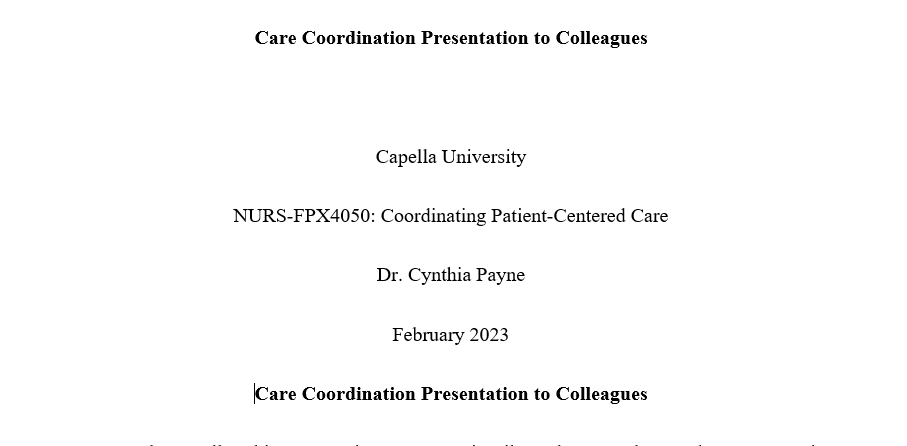Nilsa Salmon-Graham
Capella University
NURS-FPX4050: Coordinating Patient-Centered Care
Dr. Cynthia Payne
February 2023
Care Coordination Presentation to Colleagues
Welcome all to this presentation. My name is Nilsa Salmon-Graham and my presentation focuses on the relevance of care coordination and the connection with safety, ethical codes, and policy aspects. The aim is to ensure that the nursing team understands the fundamental principles of care coordination and their roles in maintaining high-quality and safe care. The high level of awareness encourages professionals to comply with the ethical frameworks that allow them to respond well to clients’ values and preferences.
Objectives
- To discuss the factors that impact care coordination and of a continuum of care.
- To make the audience aware of the policy elements helps nurses coordinate care effectively.
- To address change management issues associated with coordination and continuum of care.
- To make nurses cognizant of the care coordination process and how safety, ethics, policy, physiological, and cultural needs affect care and patient outcomes.
Care Coordination
Care coordination is the deliberate sharing of information and organizing services among parties committed to delivering quality and safe care. The objective is to sustain more effective care that captures patients’ needs and preferences (Conway et al., 2017). As nurses, we have the opportunity to understand client’s needs on time and maintain proper communication to provide safe, appropriate, and effective care to diverse consumers. The concept is essential in primary care where the care team has to remain concerned with the patient’s expectations by delivering the best care. To achieve the desired care coordination, the nursing team focuses more on improving health care delivery and adopting the best care coordination activities to improve the quality and safety of services (Möckli et al., 2021). The various approaches associated with care coordination include teamwork, medication management, health information technologies, and patient-centered practices. With the approaches, nurses can establish the desired levels of accountability, share knowledge, achieve successful transitions, and create plans that match the patients’ needs and goals. Further, care coordination allows nurses to respond to new client demands, advocate for more community resources, and align infrastructure with population interests.
Evidence-Based and Culturally Sensitive Strategies for Care Collaboration
Nurses play an important role in reforming the general approaches and routines related to nursing practices. Evidence-based and culturally sensitive strategies focus more on improving patient care and making an organization highly efficient. Adequate resources are vital for care coordination and coordination to ensure that everyone in the care team exchanges information in a timely, accurate and complete manner (Jongen et al., 2018). One of the technologies required for coordination and collaboration is the electronic health records that allow nurses and patients to adhere to the principles of quality and safe care. The innovation improves information and knowledge sharing, which allows the nursing team to handle patients in the best ways possible. In other words, evidence-based and culturally focused interventions focus more on sustainable and healthy relationships that capture the needs and expectations of the targeted population (Jongen et al., 2018). Ideally, parties involved in the treatment processes understand the importance of compassion and empathy in delivering the best patient outcomes. Similarly, there are opportunities to develop individualized plans that align with value-based care approaches required to make the healthcare environment more conducive for diverse clients. Therefore, the sustainable solution involves proactive measures that capture the interests of the workforce, patients, providers, and payers involved in maintaining evidence-based and culturally responsive practices.
Change Management and the Influence on Patient Experience
Change management seeks to enable firms to respond to complexities and the needs of diverse consumers. The primary objectives include promoting workforce engagement, delivering better services, and improving productivity across a facility. For nurses, change management involves constant adaptation to different adjustments in practices. The process requires practitioners to have the attitudes and values that make them responsive to sustainable and meaningful changes within their working environment and communities (Salmond & Echevarria, 2017). One of the essential elements of change is excellent communication that allows practitioners to capture patients’ experiences. The principles of change management describe the need for awareness, desire, knowledge, and reinforcement of the practices needed to achieve the best outcomes.
Thus, the concept makes nurses highly responsive to clients’ expectations by advocating for resources and transformations needed to make the healthcare environment more sustainable (Salmond & Echevarria, 2017). For example, the nursing team understands the need for well-coordinated and collaborated services that address disparities and challenges in care provision. The aim is to have constant improvements characterized by timely and evidence-based responses to the calls for highly effective and efficient care. The reforms arise from an organizational commitment to designing and implementing training and development programs needed to maintain positive outcomes. Change management also seeks to stress the relevance of team-focused practices that allow nurses to interact well among themselves and capture consumers’ preferences adequately. The goal is to ensure that consumers benefit from an interprofessional approach needed to improve the quality and safety of care. The team functions make nurses more reactive to customers’ demands at the local, state, and national levels.
The Need for Coordinated Care
Care coordination is important because of its contribution towards improving effectiveness, safety, and efficiency of care. The role of nurses is to have well-designed and targeted coordination to improve outcomes for patients, their families, and providers. Proactive measures could help solve persistent problems such as disjointed healthcare systems and poor information exchanges that make the system to be less efficient (Gleeson et al., 2016). Sustainable coordination involves efforts to enhance safety and quality of care in line with the recommended ethics, policies, and cultural aspects that influence nursing practice. With excellent coordination, there are better opportunities for the nursing team to share knowledge and information needed to overcome ethical dilemmas (Conway et al., 2017). A strong sense of empowerment is visible when nurses coordinate efforts in line with patients’ rights and privileges. In the real sense, nurses become more accountable and responsible for their actions because of the desire to perform exceptionally and protect consumers from the risks of readmissions, additional costs, disability, and premature deaths.
Health Care Policy and Implication on Patient Experiences
Policies influence nursing practices and standards. The aim is to assure the quality of care through reforms that help shape the care provided currently and in the future. Policies are also essential for resource allocation that support the delivery of timely and high-quality care. The Affordable Care Act is among the laws that protect the interests of people at risk of delayed treatment (Salmond & Echevarria, 2017). The policy guides providers, payers, the workforce, and other players on ways to make care more affordable and accessible to millions of citizens. The law provides subsidies that lower the cost of care for low-income individuals and families. Extended coverage, reduced fraud, and better system performance are among the aspects of ACA that help improve patient experiences. In this case, organizations and practitioners have the opportunity to streamline operations by responding effectively to population values and preferences (Hijazi et al., 2018). The provisions allow the company to make meaningful progress in achieving universal care. In the long-term, patients can access prevention and treatment services at favorable rates unlike in the past when economic constraints forced them to delay or avoid services. The Healthy People 2030 is also among the policies that describe efforts to improve health and well-being in the coming decades. The guidelines capture key indicators and the priority areas to address in sustaining more resilient public health. The policies encourage nurses to understand their role in advocating for resources and other aspects needed to deliver value-based care nationally.
Nurses’ Role in Coordination and Continuum of Care
Patients rely on nurses to help them recover successfully. The nursing team understands the approaches needed to promote quality, safe and efficient care consistent with practice standards and policies (Möckli et al., 2021). The nurses’ roles are part of the efforts to deliver holistic and patient-centered care such that it becomes crucial for organizations to ensure that have competent practitioners. The primary goal of every entity should align with the commitment to addressing healthcare disparities through well-coordinated and collaborated services. For example, nurses can rely on excellent communication among themselves and other practitioners to share knowledge and information on the best ways to deliver care. Equally, the nursing team relies on practice standards and policies to understand their advocacy roles in making services accessible and affordable to more people at the local, state, and national levels.
References
Conway, A., O’Donnell, C., & Yates, P. (2017). The effectiveness of the nurse care coordinator role on patient-reported and health service outcomes: A systematic review. Evaluation & the Health Professions, 42(3), 1-80. https://www.researchgate.net/publication/320204775_The_Effectiveness_of_the_Nurse_Care_Coordinator_Role_on_Patient-Reported_and_Health_Service_Outcomes_A_Systematic_Review/link/59dd5174458515f6efef6ac7/download
Gleeson, H., Calderon, A., Swami, V., Deighton, J., Wolpert, M., & Edbrooke-Childs, J. (2016). A systematic review of approaches to using patient experience data for quality improvement in healthcare settings. BMJ Open, 6, 1-9. https://bmjopen.bmj.com/content/6/8/e011907
Hijazi, H., Harvey, H., Alyahya, M., Alshraideh, H., Al abdi, R., & Parahoo, S. (2018). The impact of applying quality management practices on patient-centeredness in Jordanian public hospitals: Results of predictive modeling. The Journal of Health Care Organization, Provision, and Financing, 55, 1-15. https://journals.sagepub.com/doi/full/10.1177/0046958018754739
Jongen, C., McCalman, J., & Bainbridge, R. (2018). Health workforce cultural competency interventions: A systematic scoping review. BMC Health Services Research, 18(232), 1-12. https://www.ncbi.nlm.nih.gov/pmc/articles/PMC5879833/
Möckli, N., Simon, M., Meyer-Massetti, C., Pihet, S., & Fischer, R. (2021). Factors associated with homecare coordination and quality of care: A research protocol for a national multi-center cross-sectional study. BMC Health Services Research, 21(306), 1-12. https://bmchealthservres.biomedcentral.com/articles/10.1186/s12913-021-06294-7
Salmond, S., & Echevarria, M. (2017). Healthcare transformation and changing roles for nursing. Orthopaedic Nursing, 36(1), 12-24. https://www.ncbi.nlm.nih.gov/pmc/articles/PMC5266427/



